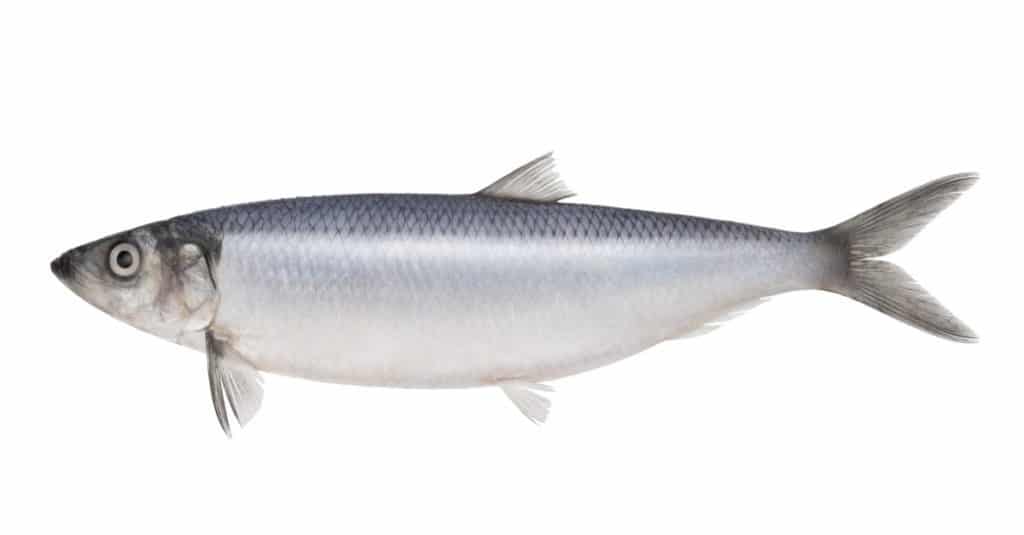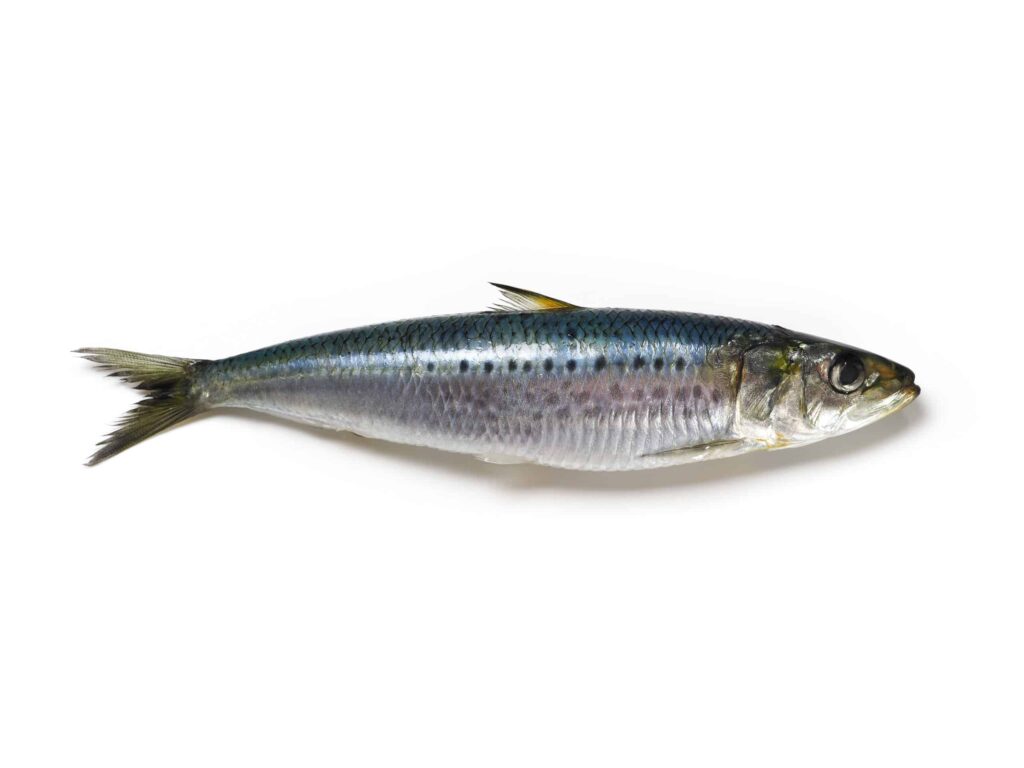Differentiating small oily fish is hard. When certain species look so much alike that they are sold under the same name, one might wonder why it’s even necessary to know how they are different. However, we will endeavor to explain some of the differences between two very similar fish. Get ready to learn about some of the differences between a herring vs. sardines and see what sets them apart from one another.
Comparing Herring and Sardines

| Herring | Sardines | |
|---|---|---|
| Size | Weight: 1-2.2 pounds Length: 9-23.6 inches | Weight: 0.2-4.5 pounds Length: 6-15.6 inches |
| Diet | – Consume zooplankton, marine worms, krill, phytoplankton, and more | – Zooplankton, phytoplankton, crustacean eggs, decapods, and fish eggs |
| Scientific Families | – Mostly from family Clupeidae, but some fish called herring are from Chirocentridae – Type genus is Clupea, including Clupea harengus and Clupea pallasii – Closely related to some sardines | – From family Clupeidae – Genera Sardina, Dussumieria, Escualosa, Sardinops, and Sardinella |
| Uses | – Canned and sold as sardines – Served salted, smoked, or pickled – Served in many specialized dishes and salads | – Canned – Served whole and fresh – Baked into pies – Frequently smoked and then served |
| Nutritional Information | – High in omega-3 fatty acids – Good source of vitamin D – Has 14.2 g protein, 1.6 grams carbs, 77 mg calcium, 1.22 mg iron, and 870 mg sodium per 100 grams of pickled herring. | – High in vitamins B2, B12, and D along with potassium, phosphorous, and others – A good source of omega-3 fatty acids – Exceptionally low mercury levels compared to other fish – Has 24.6 g protein, 0 carbs, 382 mg calcium, and 2.92 mg of iron per 100 grams |
The Key Differences Between a Herring vs. Sardines
The greatest differences between herring and sardines can be found in their potential size and phylogenetic families. Fish considered sardines are often heavier than herring, weighing between 0.2 and 4.5 pounds compared to the herring, which tops out at 2.2 pounds. Meanwhile, herring can grow longer than sardines, maxing out at 23.6 inches in length, while sardines max out at 15.6 inches.
Although both fish come partly or completely from the Clupeidae phylogenetic family, herring comes from different genera than sardines. The type genus of herring stems from Clupea, while the type genus of sardines comes from Sardina.
These are not the only differences between herring and sardines, but they are two of the easiest ways to differentiate the two creatures. We’ll take a closer look at these creatures and see other ways to tell them from one another.
Herring vs. Sardines: Size

Fish called herring belong to a different phylogenetic family, Clupeidae.
©ILYA AKINSHIN/Shutterstock.com
Generally speaking, herring are longer than sardines, but sardines can get heavier than herring. The average herring weighs between 1 and 2.2 pounds while measuring between 9 and 23.6 inches in total length. Meanwhile, sardines can grow between 6 and 15.6 inches in length and weigh between 0.2 and 4.5 pounds.
Herring vs. Sardines: Diet
Herring and sardines consume many of the same creatures. Both creatures consume phytoplankton and zooplankton and the eggs of marine animals. However, herring are known for eating marine worms, which sardines are not known to consume as often. This is a minor difference between the creatures, but it’s one more way to tell them apart.
Herring vs. Sardines: Scientific Families
The names herring and sardine are sometimes mistakenly applied to each creature because they’re similar-looking, oily fish that have a lot in common in terms of taste and nutrition. Fish called herring belong to a different phylogenetic family, Clupeidae. Some fish called herring belong to the Chirocentridae family. Sardines also belong to the family Clupeidae.
The overlap between these fish families and the fact that herring are sometimes canned and sold as sardines adds to the confusion surrounding their identity. However, the type genus of herring is from the Clupea, but the most common sardine stems from the Sardina genus despite other sardines coming from Dussumieria, Escualosa, Sardinops, and Sardinella.
Overall, these two fish come from different genera of the same family for the most part, but they’re still closely related.
Herring vs. Sardines: Uses

Sardines have a lower mercury content than other fish, making them a potentially healthier alternative to tuna.
©optimarc/Shutterstock.com
Both types of fish are consumed in a variety of ways. Often, herring and sardines are sold canned. Sometimes, canned herring are marketed and sold as sardines.
Sardines are baked into pies, served whole and fresh, smoked and then served, and more. Herring are also consumed after being salted, smoked, and pickled. Sardines are also used in specialty dishes and salads.
Sardines and herring are both important foods for humans and are especially popular in Europe. Cultures in Norway, Germany, and Sweden have delicacies made from these fish, including surströmming and pickled herring.
Herring vs. Sardines: Nutritional Information
Herring and sardines are popular fish to eat because of their great nutritional value. Both fish are very high in omega-3 fatty acids, and herring are a good source of vitamin D. Sardines are high in vitamins B2, B12, and D, potassium, phosphorous, and more.
Also, sardines have a lower mercury content than other fish, making them a potentially healthier alternative to tuna. Herring has 14.2 g of protein, 1.6 grams of carbs, 77 mg of calcium, 1.22 mg of iron, and 870 mg of sodium per 100 grams of pickled herring.
Sardines have 24.6 g of protein, 0 carbs, 382 mg of calcium, and 2.92 mg of iron per 100 grams of fish.
All in all, these fish are both healthy options that can be integrated into various meals throughout the day.
Sardines and herring are very similar fish. Even knowing that they are different species and have different nutritional values, it can be very difficult to tell them apart from one another. Unless you have a keen eye or experience with these fish, you’ll probably rely on labels to determine which fish is which!
Up Next:
- Sardines vs. Tuna: What Are The Differences?
- Sardines vs Anchovies: What’s the Difference?
- Sprats vs. Sardines: What Are The Differences?
The photo featured at the top of this post is © iStock.com/Ralers
Sources
- FishBase, Available here: https://www.fishbase.se/summary/Sardinops-sagax.html
- ResearchGate, Available here: https://www.researchgate.net/figure/Sardines-composition-by-United-States-Department-of-Agriculture-USDA-113_tbl3_348292168
- U.S. DEPARTMENT OF AGRICULTURE Agricultural Research Service, Available here: https://fdc.nal.usda.gov/fdc-app.html#/food-details/175118/nutrients
Thank you for reading! Have some feedback for us? Contact the AZ Animals editorial team.






